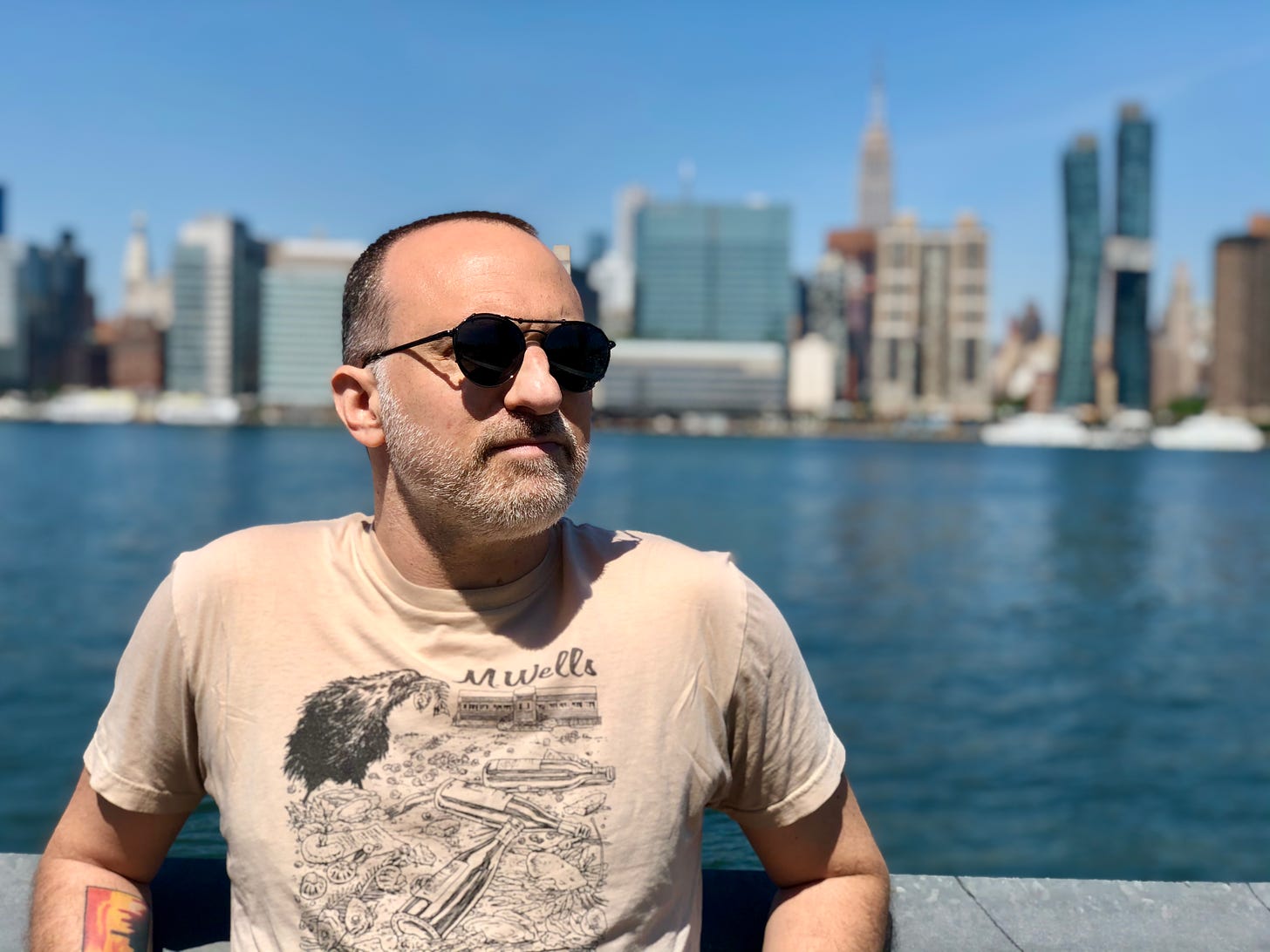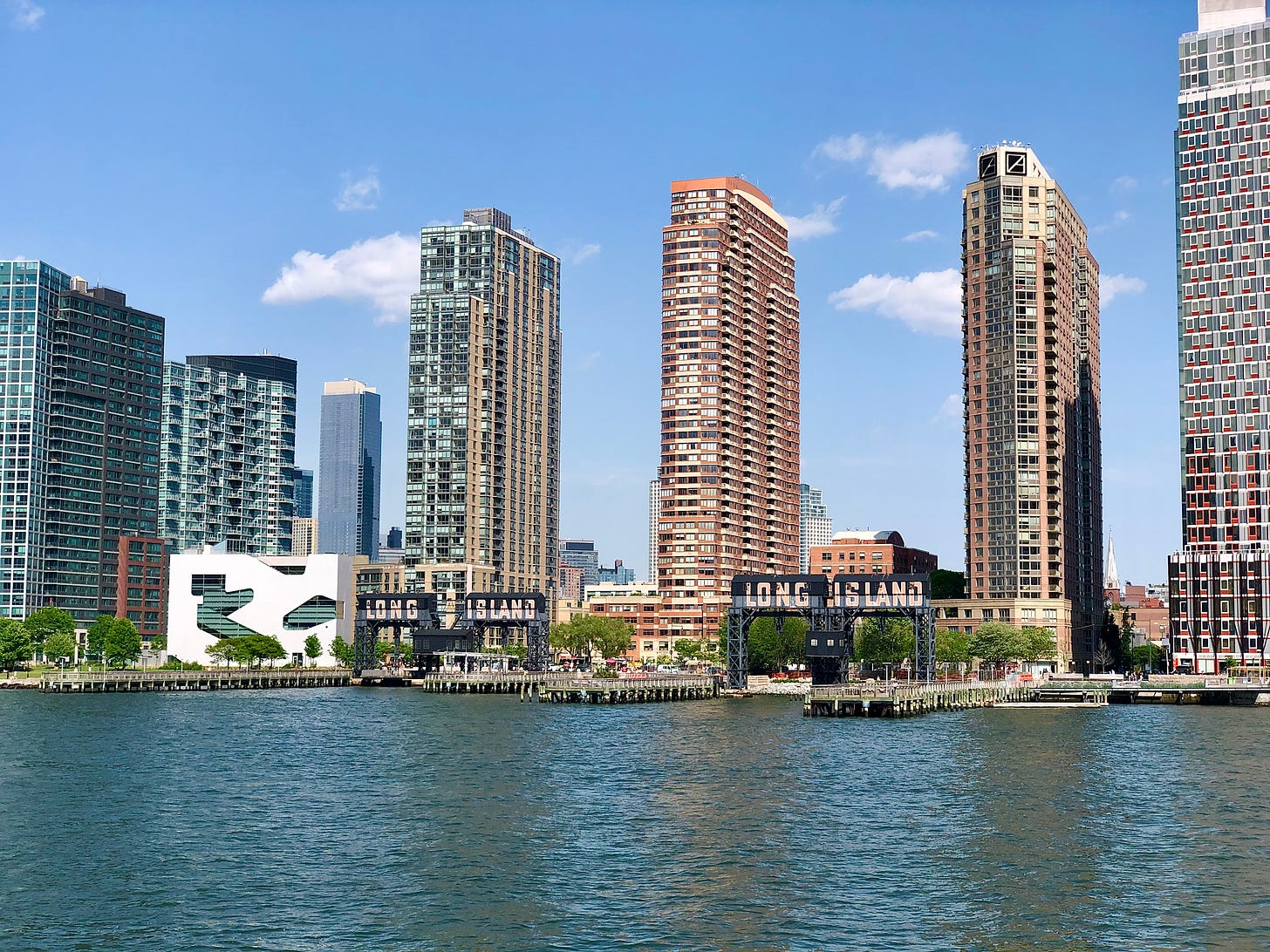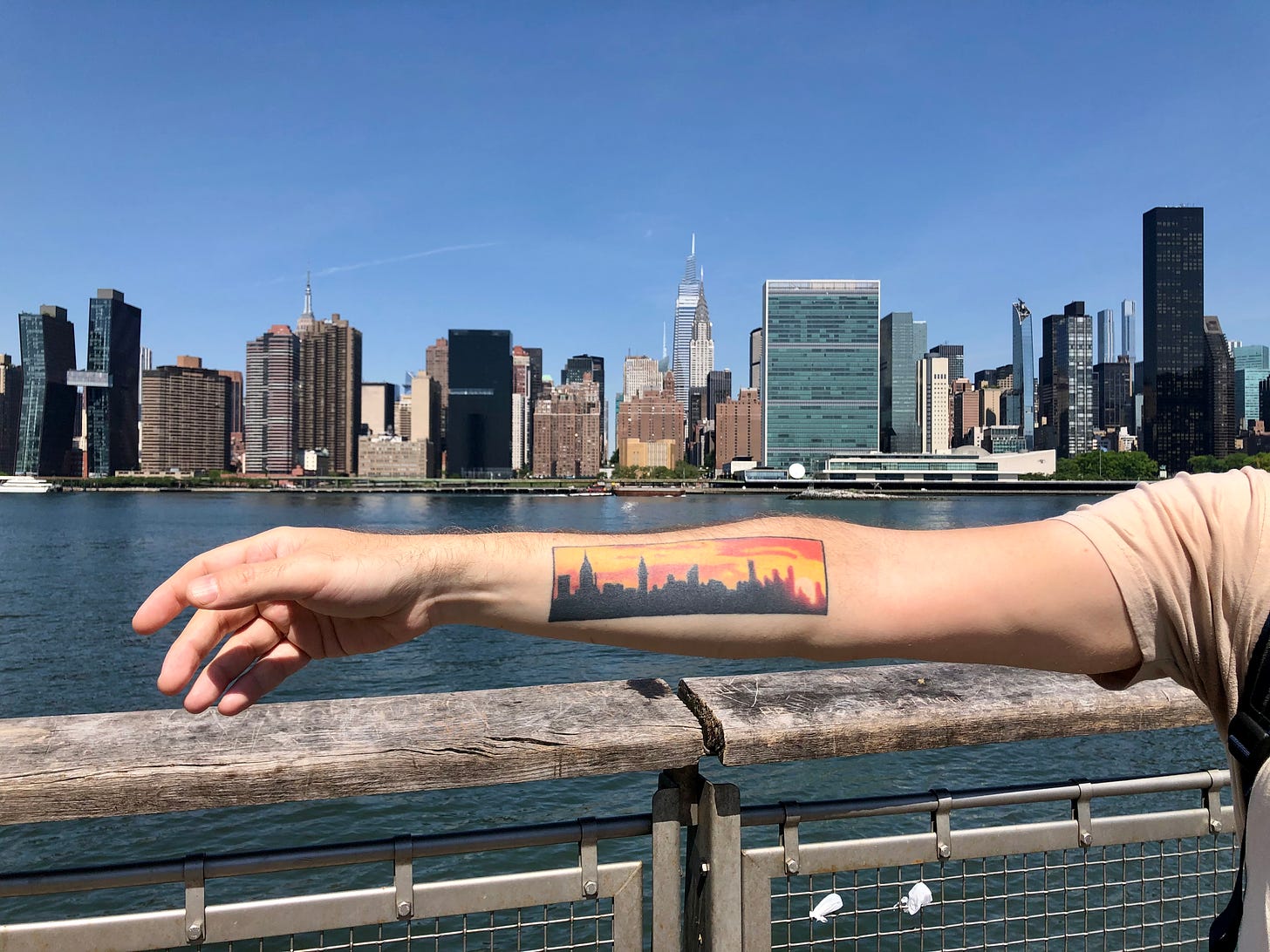A Walk with Dan Saltzstein in Long Island City
"Queens is the throbbing heart of New York City. It’s where the spirit is, and it’s where the pretension isn’t."
“It was one of my favorite restaurants in the city, but it was also one of my favorite times—one of my favorite slices of time—in New York.”
Dan Saltzstein and I are standing at 21-17 49th Avenue in Long Island City, Queens, NY. The diner behind us is covered in graffiti, but it used to be the home of M. Wells, a Quebec-American bistro that Hugue Dufour and Sarah Obraitis started in the summer of 2010, only to close a year later in 2011.
“It was a dispute with the landlord, I think. Things change. But they did reopen at a new location.”
Dan lives on the border of Sunnyside and Woodside, but has ventured down to Long Island City to show me Gantry Plaza State Park. We walk past Italian social clubs and the small, eclectic houses that are holding the line against the neighborhood’s ever-growing number of high-rises.
“There used to be two high-rises in Long Island City. Now there are 70? 80? A friend told me a couple of years ago the only place in the world with more high-rise construction than LIC is Dubai.”
We walk past Takumen, a Japanese izakaya where we’ll eventually stop for lunch. But before eating we make our way down to the waterfront and marvel at the gantries. These cranes used to unload cargo from ships and then load that same cargo back onto trains, which would in turn bring the goods into Queens and then deeper on into Long Island.
“You can still see the remnants of train tracks,” Dan tells me.
This is where Dan and his wife, Nancy, were married in 2007. We look across the East River at Manhattan. That skyline used to be a lot different too. Like Dan said, things change.
We meander through Gantry Plaza State Park and on into Hunters Point South Park. It isn’t until we’ve been walking most of the afternoon that I realize Dan is wearing a M. Wells t-shirt.
Isaac Fitzgerald: How long have you lived in Queens? What do you love about Queens?
Dan Saltzstein: I’ve lived in Queens for over twenty years. I got married in Queens. Started my family in Queens. And it is by far—in my opinion—the most interesting borough. It’s one of the most diverse places in the world. It is also vast in terms of size. Even after living here for decades, I’ve only explored a tiny fraction of what Queens has to offer. Because Queens is a bit endless.
The food in Queens is incredible. There are so many immigrant communities and first generation restaurateurs. Let’s, for example, only focus on Thai food—because if I listed different types of restaurants we could be here all day. Woodside and Elmhurst are where a lot of the really good Thai places are. There’s sort of a holy trinity from, say, fifteen or twenty years ago: SriPraPhai, Ayada, and Chao Thai Too. We still go to SriPraPhai and Ayada—Chao Thai Too is closed, sadly—but now our favorite place is Lamoon. It’s Northern Thai food that is absolutely spectacular. The food is so fresh. So delicious.
Another place I have to talk up is right around the corner from where we live on the Sunnyside/Woodside border. It’s called Dawa's, and is co-owned by a wonderful chef, Dawa Bhuti. She’s classically trained and worked at some fancy restaurant in Manhattan for a few years, but then decided to open up her own place in Queens where there’s a very large Tibetan and Nepalese population. Her restaurant has two menus: the Himalayan menu—which has fantastic takes on classic dishes like thenthuk, a bone broth soup with noodles, and momo, which are Tibetan dumplings—and the American menu, which is impressive in its own right.
I: Ok, so to be clear, we are off Thai food now.
DS: Yes, but over the last year, as restaurants struggled, Dawa’s was the place I was the most worried about. It’s our favorite place in the neighborhood. So I tell everyone I can about it. But I spoke to Dawa recently and I’m happy to report that they seem to be doing ok.
So it’s the diversity, it’s the food, and really it’s the borough itself. Queens is filled with so many gems. So many people. There’s a warmth, too. The area where we live is an incredibly friendly neighborhood. For me, Queens is the throbbing heart of New York City. It’s where the spirit is, and it’s where the pretension isn’t.
I: And I feel you’re qualified to say that. How long does your family go back in New York City?
DS: My mother is the daughter of immigrants from Hungary, who met in New York. She grew up in Inwood, in Manhattan. She is a classic first generation success story—went to Bronx High School of Science, and then put herself through NYU with scholarships.
My dad grew up in Crown Heights, in Brooklyn. His grandparents were immigrants, so one more generation back—the turn of the century versus the 1920s, when my mom's parents came over. My dad's family is a combination of Russian, Polish, and Hungarian. Classic shtetl Jews.
I’ve done some research into my family history. When I first started working at the New York Times 22 years ago, one of the things you can do is search for things in the archives. So I searched my last name, which is an unusual name and unusually spelled. Five consonants in a row, right in the middle. So I looked up my name and a handful of results popped up. My dad was in there, at one point, because he was a professor and researcher in psychology. His uncle—so my great uncle—was in there also, because he was a bookmaker for the Gambino crime family.
I: Holy shit.
DS: Yeah. I also found someone with the same last name who ran the B&B Carousell out on Coney Island for 25 years. I’m still trying to figure out if we’re related, but it is such an unusual name—let’s just say I’m still trying to track that story down. I want to write about it at some point.
I: Speaking of the New York Times, you started there working on the website in 1999. And the website had kind of just started, right?
DS: Well, the website started in 1996, but it was still very much in its early stages. As was I. It was one of my first real jobs out of college. I started freelancing for them in ‘98, and then I was full-time in ‘99. I was a producer, and then an editor—I worked at the website for about ten years. My last job there was Arts Editor. But, for the most part, I wasn’t really editing much—it was more of a managerial job. Back then there was the web side of things and the print side of things, so I felt lucky when I was able to transfer from web to print. I think I was the first person to transfer from a fully web job to a fully print job at the paper. So I was learning on my feet. I learned how to edit by being edited, and by working with other editors. I learned how to put together a print section thanks to my coworkers, when I moved to the print Travel section. It’s been an amazing experience.
I: And what’s your title now?
DS: I’m the Deputy Editor for Special Sections.
I: With that in mind I wanted to ask, what do you look for in a story?
DS: There are three questions to ask yourself when you’re pitching a story—and it also works in reverse. These are the three questions I ask myself when I’m evaluating a pitch. They are:
1. Why—which is to say, “why is this story interesting?”
2. Why now—which is to say, “why is now the time we should run this story?”
3. Why me?—which is to say, “why are you the person to write this story?”
And there are numerous and varied answers to all of those questions, many of them good, but those are the three questions that I think should be answered before pitching—or accepting—a story. You don't have to have an answer to each question, but they are always worth asking yourself.
I: What are some of your favorite pieces or packages that you’ve worked on over the years at the Times?
DS: I’ve gotten to do a handful of writing assignments that I’m very proud of. I wrote a story about Marc Maron in early 2011—focused on his podcast—which was some of the first coverage of podcasts that the Times ever did. He's talked about how big it was for his podcast and for podcasts in general. For Travel, I wrote about taking my family on a Disney cruise, which got a tremendous response—not all of it positive, but that’s fine with me. Still, the most fulfilling thing for me by far is, as an editor, getting to work with smart, interesting writers—including up and coming writers. I absolutely love working with a writer when they’re publishing their first piece in the Times.
[Editor’s note: Dan Saltzstein, along with Adam Sternbergh, edited my first piece in the Times.]
Last year I co-edited—with Lauren Katzenberg—a “World War II After 75 Years” section, which our mutual friend Alexander Chee wrote for. I also edited a Pride section for the 50th anniversary of first Pride Marches—with three lead essays by Jericho Brown, Carmen Maria Machado and Thomas Page McBee. When I was at the Travel section I edited two love story packages, working with writers like Rumaan Alam and Dan Chaon. So I really love bringing different voices into the Times, and learning how to edit different styles of writing. It’s something that is really satisfying, and something that I’m very proud of.
I: Were you at the website when 9/11 happened? Did that day change the Times approach to publishing online?
DS: Things changed a lot between 2001 and, say, 2005. Look, it takes a long time to turn a big ship. The Times was very print focused. The website was an afterthought, in many ways. The staff that worked on the website were in a different building than the staff that worked on the print side for years. But, yes, 9/11 did bring a lot of attention to the website, largely because people, understandably, wanted up to the minute information. The traffic on that day was so huge—nothing by today’s standards, mind you—but there was so much traffic that we had to reduce the entire website down to a handful of stories that we were constantly updating throughout the day, and then rebuild the website from there. The servers couldn’t handle the traffic.
So yes, 9/11 did plant the seed of, “There is a web audience.” But it took until, I would say, the mid 2000s before the Times began seriously investing in the website. Eventually I got a desk where the print staff worked, and people would come up to me and say, “Are you the web?” And I’d be like, “Yeah, I’m the web. How can I help you?” Which is wild to think about, because now we’re a completely digital first operation.
The paper is, of course, amazing. It is a beautiful paper and, in my opinion, is the best looking and the best written paper in the country. But the vast majority of people consume our content on web and mobile. So we have come an enormously long way from fifteen years ago or so. Even in the last ten years you can see so much change. When I made that change from web editor to print editor, my thinking was, “Well, eventually we’ll all be hybrid editors. We’ll go wherever the content goes.” And that’s what’s happened. And continues to happen. Podcasts. Newsletters. Evolving, constantly changing delivery methods that aren’t just a paper on your doorstep.
Dan has walked me to the Hunters Point South ferry terminal. He heads back to his home on the border of Woodside/Sunnyside, and I decide to take the ferry back to Brooklyn. The summer heat cools out over the water, and I sit on the top deck. Taking in the ever-changing skylines on both sides of the East River.
I order a beer below deck and strike up a conversation with the boat’s bartender, Candace. She’s from Arizona but moved to New York City with her fiancé, who grew up here. She’s been working on the ferry for a little over two years. We talk about weathering the pandemic.
“It was hard, no doubt. But I’m just happy to be working again. To be out on the water.”
I inquire about her favorite part of working on the ferry. She thinks for a moment and then says, “Interacting with the passengers. Each route? Different people. Different stories. And the view ain’t bad either.”
When I ask her which route she loves the most, “The Astoria route, for sure.”
I thank Candace for the conversation and make my way back to the upper deck. I’m thinking about what shifts we’re experiencing now. What new ways of doing things might emerge from the moment in history we all just lived through.
Maybe it’s the views, or the beer, or simply how much I enjoy being on boats, but I miss my stop at Pier 1 in Dumbo. The ferry heads straight to Pier 11 in Wall Street. End of the line. We disembark, and I am not as close to home as I was hoping to be. But that’s my new reality. I remember Dan talking about the changing skylines of Long Island City and Manhattan. He has a tattoo of the view from one of his old apartments in Queens. The city skyline at sunset on his arm. When we were walking by the water, he held it up against Manhattan to show the difference between the two. The variations that now exist, even in a few short years’ time.
I head towards the Brooklyn Bridge, deciding to walk back to my apartment, and wonder what change is coming next.















What a luscious read! thank you.
"It’s where the spirit is, and it’s where the pretension isn’t."
Until people like you began moving in.
"The neighborhood is over. The Americans are moving in." A friend from the Netherlands, in 2005.
Americans used to come to NY to escape provincialism. Now they come to wallow in it.